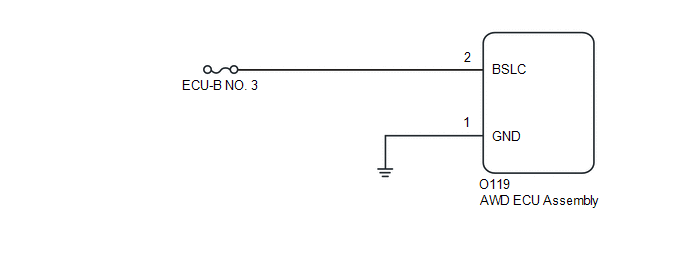Toyota Yaris: Active Torque Split Awd System / Linear Solenoid Power Supply System Circuit Voltage Out of Range (C120C1C)
DESCRIPTION
When a malfunction has occurred in the linear solenoid power source system, the AWD ECU assembly stores DTC C120C1C.
| DTC No. | Detection Item | DTC Detection Condition | Trouble Area | Warning Indicate | Memory |
|---|---|---|---|---|---|
| C120C1C | Linear Solenoid Power Supply System Circuit Voltage Out of Range | When the IG1 terminal voltage is 9.5 V or more and less than 17.0 V, the BSLC terminal voltage is less than 9.5 V for 1 second. |
| Displayed | Yes |
WIRING DIAGRAM

CAUTION / NOTICE / HINT
NOTICE:
- Inspect the fuses for circuits related to this system before performing the following inspection procedure.
-
When the AWD ECU assembly is replaced, before removing the AWD ECU assembly, it is necessary to perform ECU Data Save to save the original AWD ECU assembly information.
Click here

-
After performing repairs, clear the DTCs and check that the DTCs are not output again.
Click here

PROCEDURE
| 1. | CHECK HARNESS AND CONNECTOR (BSLC TERMINAL) |
(a) Turn the ignition switch off.
(b) Disconnect the O119 AWD ECU assembly connector.
(c) Measure the voltage according to the value(s) in the table below.
Standard Voltage:
| Tester Connection | Condition | Specified Condition |
|---|---|---|
| O119-2 (BSLC) - Body ground | Always | 11 to 14 V |
| NG |
 | REPAIR OR REPLACE HARNESS OR CONNECTOR |
|
| 2. | CHECK HARNESS AND CONNECTOR (GND TERMINAL) |
(a) Turn the ignition switch off.
(b) Disconnect the O119 AWD ECU assembly connector.
(c) Measure the resistance according to the value(s) in the table below.
Standard Resistance:
| Tester Connection | Condition | Specified Condition |
|---|---|---|
| O119-1 (GND) - Body ground | Always | Below 1 Ω |
| OK |
 | REPLACE AWD ECU ASSEMBLY |
| NG |
 | REPAIR OR REPLACE HARNESS OR CONNECTOR |
 4WD/AWD Range Actuator Temperature Sensor Circuit Range/Performance Circuit Voltage Out of Range (C11411C)
4WD/AWD Range Actuator Temperature Sensor Circuit Range/Performance Circuit Voltage Out of Range (C11411C)
DESCRIPTION When a malfunction has occurred in the AWD coupling solenoid system, the AWD ECU assembly stores DTC C11411C. DTC No. Detection Item DTC Detection Condition Trouble Area Warning Indicate Memory C11411C 4WD/AWD Range Actuator Temperature Sensor Circuit Range/Performance Circuit Voltage Out of Range
Even though it can be inferred from the driving conditions that the coupling is generating a significant amount of heat, the temperature sensor value is approximately -10°C (14°F) for 1 second or more, and this continues despite the ignition switch being turned off and then ON again 2 times
Even though the engine coolant temperature received from the ECM is less than 35°C (95°F), the temperature sensor value is fixed at 155°C (311°F) (short circuit condition), and this continues despite the ignition switch being turned off and then ON again 2 times
The temperature sensor power source voltage is 0...
 Supply Voltage Circuit Circuit Voltage Out of Range (C123A1C)
Supply Voltage Circuit Circuit Voltage Out of Range (C123A1C)
DESCRIPTION When a malfunction has occurred in the power source circuit, the AWD ECU assembly stores DTC C123A1C. DTC No. Detection Item DTC Detection Condition Trouble Area Warning Indicate Memory C123A1C Supply Voltage Circuit Circuit Voltage Out of Range
At a vehicle speed of 3 km/h (2 mph) or more, the IG1 terminal voltage is less than 9...
Other information:
Toyota Yaris XP210 (2020-2025) Reapir and Service Manual: Components
COMPONENTS ILLUSTRATION *1 REAR AXLE HUB AND BEARING ASSEMBLY *2 REAR AXLE SHAFT NUT *3 REAR DISC BRAKE CALIPER ASSEMBLY *4 REAR SPEED SENSOR *5 REAR FLEXIBLE HOSE *6 REAR DRIVE SHAFT ASSEMBLY *7 REAR BRAKE *8 REAR DISC *9 PARKING BRAKE SHOE ADJUSTING HOLE PLUG - - Tightening torque for "Major areas involving basic vehicle performance such as moving/turning/stopping" : N*m (kgf*cm, ft...
Toyota Yaris XP210 (2020-2025) Reapir and Service Manual: Removal
REMOVAL PROCEDURE 1. REMOVE DECK TRIM SIDE PANEL ASSEMBLY LH Click here 2. REMOVE RADIO SETTING CONDENSER NOTICE: When the terminal cover is removed, the radio setting condenser must be replaced because the terminal cover and condenser are supplied as a set...
Categories
- Manuals Home
- Toyota Yaris Owners Manual
- Toyota Yaris Service Manual
- Maintenance
- Fuse Panel Description
- Adjustment
- New on site
- Most important about car
Break-In Period
No special break-in is necessary, but a few precautions in the first 600 miles (1,000 km) may add to the performance, economy, and life of the vehicle.
Do not race the engine. Do not maintain one constant speed, either slow or fast, for a long period of time. Do not drive constantly at full-throttle or high engine rpm for extended periods of time. Avoid unnecessary hard stops. Avoid full-throttle starts.
